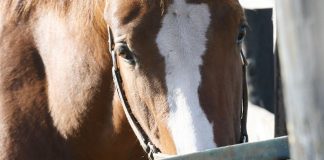
Do you want your horse to be happy, relaxed and ready for your next ride? For your horse to feel his best, he needs time with other horses when you can’t be around.
Do Horses Get Lonely?
Horses actually depend on the herd for a feeling of well being. In the herd, they exist cooperatively: they stand head to tail to help keep pests away and they guard one another so that they can feel safe enough to sleep. If a horse is alone, he may never fully relax. He’ll always be the one that has to watch the horizon—constantly on guard.
When horses are alone, their behaviors can change and they are often depressed. They may develop repetitive stress behaviors, such as weaving or pacing in a stall.
While not all horses can always be with a herd, you can make housing and turnout choices to include his socialization needs. If you have a small property, a performance horse that needs to be kept safe, or a horse with health or behavior issues, you may need to keep him alone for part of the day. That’s OK, as long as you do your best to provide natural elements.
A horse would rather be with other horses. How Mustangs live in the wild is what your horse would choose for himself. A horse wants wide-open spaces so that at any moment he can flee from a predator. While humans think that a small, warm space with high walls is comforting, horses are comforted by seeing the horizon and accessing open spaces. Your horse wants turnout time outside with other horses. It’s time to think like a horse and think about how your horse wants to live.
Horses Home Alone
If you have an only horse, I think you have a responsibility to provide some form of 24-hour-a-day companionship. At the very least, your horse will feel more comfortable if he can see other horses. If possible, make sure your horse shares a safe fence line with a neighboring horse. However, he will be most comfortable if he can touch another horse. Touching, nipping, grooming, swishing tails and even being able to bite is important to a horse’s overall well being.
If you are the only one your horse has, make sure to enrich his life. In addition to riding, stimulate his mind and occupy his time with long walks. You may also give him obstacles and novel items to interact with in his paddock.
Ideally, getting a buddy horse is the best answer. A miniature donkey or even a goat can be a great substitute. I’ve even seen a horse bond with a duck or a cat. Your horse can also bond with a dog, but that doesn’t work if you take your dog inside. Your horse can get companionship from any animal, but that companionship is best provided by another horse or a similar species.
Horse Boarding Choices
My horses are together outside all day and then come into stalls with runs in the evening. That separation time works for us because that’s how we feed separately and manage their different supplement and diet needs. At that time, they can all see one another, touch each other through openings in the dividers and access their outdoor runs so that they can see the horizon. They are all ready to go out first thing in the morning. They don’t tend to stay in their stalls unless they are seeking shelter from the weather.
If you board your horse, the most ideal scenario is having your horse turned out with other horses. Choose as much outdoor access and herd turnout as possible.
Horses can learn to like their stalls, but I say learn purposefully. If your horse is stalled, choose a stall with a window that allows him to see the horizon. New, well-designed barns have indoor walls made of mesh so that horses can see one another and even touch through the walls. That is preferable to a solid wall.
Choose an attached run so he can move in and out to see other horses. That is preferable to a stall that is dark and inside only. A long and narrow run is preferable to a square pen. A long run is designed for the horse’s benefit because he wants to play and act out his flight response and run in a straight line. A square pen that only allows him to run in a circle is not satisfying to the horse.
No matter where your horse lives, take a moment to evaluate his interaction with others and his ability to see the horizon. Build in as many natural views and interaction opportunities as possible and you’ll have a healthy horse—and a healthier relationship with your relaxed and calmer riding partner.
More from Julie Goodnight:
Unsafe Mistakes We Make Around Horses
Fear Management
This article originally appeared in the September 2015 issue of Horse Illustrated magazine. Click here to subscribe!






I certainly understand how much my horses enjoy being out with others. My mare, gelding, and donkey are out together at home but…. I have a gelding that I show and I have him boarded. Prior I had my mare there who was repeatedly kicked and bitten, at times I could not ride her for weeks. I finally had her put in a private turn out, next to the other horses but not with them. With boarders coming and going, the dynamics of the herd constantly changing, there is always some turmoil going on. I don’t want this gelding going through the same thing, I don’t want him hurt like she was and I don’t want the risk that he could be seriously hurt like others have been. Again he has contact with those horses in the turn outs around him, he has contact with open bars next to horses in his stall when weather is really bad.